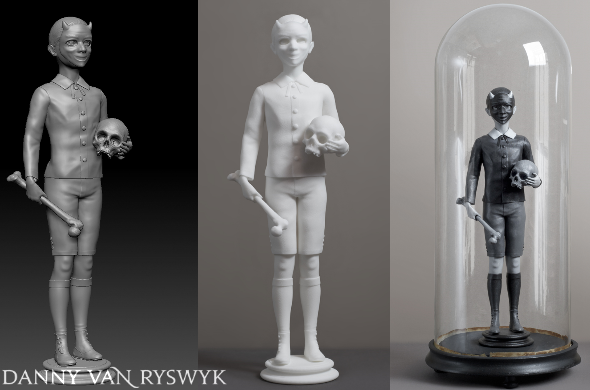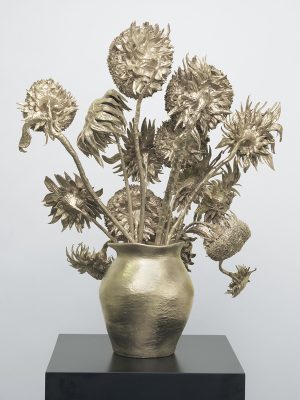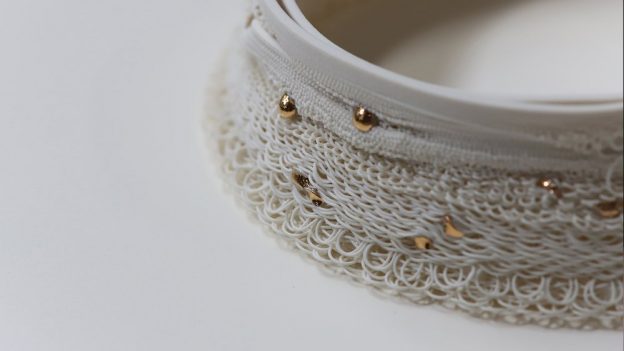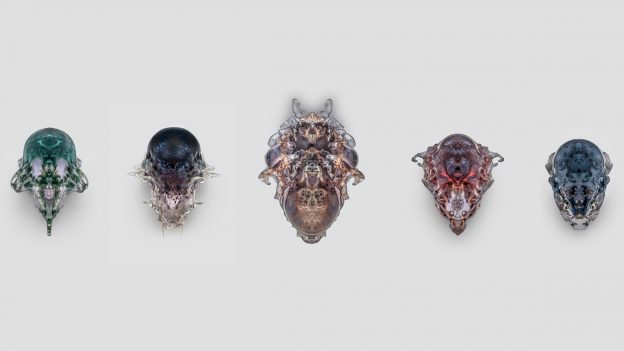3D printing technologies and trailblazing 3D design software have the potential to open up new frontiers within the creative process of art forms including ceramics, installation art, fine art, sculpture, theatre, dance, fashion and music – to name but a few. The art world has a great deal to gain from additive manufacturing since 3D printing removes many of the limitations of traditional art manufacturing methods and minimizes challenges within the creative process itself, if used wisely. Artists should embrace the varying opportunities in this arena and harness the potential of 3D printing to minimize challenges relating to geometry, scale, time, production accessibility, quick customization and cost.
For example, if an artist has a 3D printer at home, they can potentially (and affordably) make anything their mind can imagine, subsequently, sharing their work(s) with greater ease and without the need for employing a manufacturer or other previously essential stakeholders for distribution. Designs previously impossible to make and share are now very much feasible thanks to 3D printing, creating greater art career opportunities than ever before.
3D printing writer, Alina Dragu says:
“3D printing is a remarkable way for today’s artists to create outstanding pieces of art that not only reflect the message they want to send but also make their art more accessible to art lovers. All artists are trying to say something with their art, whether it’s a political statement or developing a scene, they have a message they are trying to convey. By using 3D printing, they can make sure their message is going to come across precisely as they want.”
Art, as an ever changing concept pertaining to individual and shared reaction as well as universal human expression, continues to make use of the latest additive manufacturing technologies out there. Let’s briefly explore how.
Breaking Down Art Barriers with 3D Printing
All artists can benefit: While sculptures as an art format have of course always been 3D in dimension, 3D printing technology enables all artists and designers to transform their creations directly into impressive 3D printed concepts and/or produce with greater ease. It also means that when 3D works of art are brought to life, there is less of a need for several ‘draft’ versions of a piece of work. Indeed, artists can ‘solve’ many of their aesthetic design problems that arise during the creative process by using 3D printing software before their art is finally printed in real life.
Scale, geometry and production: Artists have historically been held back in design and production by issues of scale and geometry both in creating very small and very large pieces. The detailing on small art pieces can only be so intricate and attempts at very large pieces can be extremely difficult without expensive resources. The digital workflow of additive manufacturing and 3d printing software removes some of these restrictions.
Lower costs, less waste and less time wasted: 3D printing can speed up the time in which art can be created meaning artists no longer need to spend months or even years (!) on a single work or series. Regular manufacturing methods don’t allow you to make customizations or alterations as you go with no return. You’d need to use different molds, manual measurements or templates each time which is time consuming and potentially expensive. Not to mention there is a lot of waste materials left over in this type of process. With 3D printing any changes are made within a digital file and it takes mere moments to create subsequent designs and print them. Subsequently more of the artist’s time can be spent on the creative process itself than accounting for mistakes or practical inefficiencies.

Sculpture created by Danny Van Ryswyk
As design writer Kristine Hansen says:
“Contrary to what some may think, the practice of 3D printing—making objects out of digital files—is not all about churning out works in large numbers; transforming an art form into a veritable machine or factory. Instead, this technology enables artists to further perfect their craft.”
Greater career opportunities: With 3D printing however, there is the opportunity to produce artwork in large numbers with speed and ease if that is the goal. This means that new artwork, restored artwork and recreated artwork can potentially reach more people than ever before and there are diverse careers to be pursued in 3D printed art moving forward. There are also opportunities in different sub sectors such as that of jewelry design whereby 3D printing can enhance and simplify the production process especially where there is a need for customization. Jewelers can use 3D printing technology to customize pieces from prototypes and are able to save, access and alter designs digitally before crafting items using expensive materials such as gold, platinum and diamond where even the smallest mistake is noteworthy and costly.
Then there’s ceramic artists, as another example, who can cheaply and efficiently design, prototype and self produce large quantities of identical items, based on a single, easily—preserved design stored digitally. The potential therefore to set up your own art business (on your own terms) is greater than ever and is a seriously exciting concept for many out there wanting to break into this space.
There could also be greater career opportunities in art thanks to 3D printing’s involvement in the restoration of historical artwork. Antiques or artwork with missing elements can be restored with greater accuracy via 3D scanning of pieces prior to restoration, before digital modeling software is used to recreate missing components. 3D printing can then be used to create prototypes and final materials for such projects.
3D printing can also reinterpret famous works of art. Rob and Nick Carter create sculptures - inspired by centuries-old paintings through 3D printing, while Tomoko Nagao, a Japanese artist, reinterprets Renaissance masterpieces using 3D printing.

3D printed bronze replica of Van Gogh's Sunflowers by Rob and Nick Carter
3D Printing within the Creative Process of Art Formation
Next level sculptures: There are countless 3D sculpture artists using additive manufacturing to make their incredible visions come to life. For example, ceramic artist Nico Conti has been turning heads at this year’s virtual Collect art fair where he combines computer design and 3D printing with inspiration from classical ceramics, architecture and nature.
Then there’s painter and sculptor Danny van Ryswyk who combines traditional techniques with 3D software to produce Gothic inspired 3D characters. Lorna Barnshaw uses an array of 3D technologies to create mask-like portrait sculptures of the human face, while Julian Voss-Andreae’s famous 3D art sculptures depict larger-than-life outdoor monuments of the human form.

Nico Conti's Of Lace and Porcelain 3D prints
3D printed fashion as art: 3D printing can be used within the art form of fashion to bring designers’ concepts to life using unique methods and materials. Notably, fashion designer and researcher Mingjing Lin uses 3D printing to blend traditional and modern elements, while renowned MIT professor, designer, architect and artist Neri Oxman’s artistic experiments push the boundaries of 3D printing and art.
Danit Peleg is one to watch too. She has created a platform where consumers can get their hands on 3D-printed fashion. In fact, Peleg believes that 3D printing will transform how we purchase our clothes in the years to come and that one day, shoppers will be able to download their clothes and print them at home – or create their own designs more easily.
Then there’s of course the trailblazer of 3D printed fashion, Iris van Herpen, who was the first to ever send a 3D printed fashion piece down the runway back in 2010. Fashion designers including Mia Vilardo and Riccardo Polidoro of Miryaki are also taking advantage of 3D printing, to name but a few.

Collection of 3D printed death masks created by Neri Oxman
3d printing art software: Programs that enable artists to adopt 3D printing as part of their creative process include the PotterDraw program, Blender, MatterControl 2.0 and Slic3r. Then there’s technology such as GrabCAD Shop that brings order, ease and collaboration to your 3D printing art shop should you need it and want to expand your at home 3D printing entrepreneurial empire. The opportunities really are endless.
Conclusion
3D printed art is a highly empowering and fast evolving manufacturing sector which offers increasing career opportunities across all art areas, whilst promising great efficiency in time, production and cost as well as more flexibility in scale, geometry and easy customization. Artists of all kinds have the potential to benefit from 3D printing and you can expect to see much more integration of this technology as it becomes more mainstream. Equally, if you’re looking for a way to stay ahead of the game as an emerging artist, whatever your sub-sector, look into how you can harness the power of 3D printing to stand out from the crowd.
According to 3D printing writer Wim Dodson:
“3D printing technology may be one of the hottest trends today—but it’s not a fad. It’s poised to change the way artists create and the way people consume art. There’s a myriad of opportunities to explore, and who better to push the boundaries of 3D technology than artists challenging the status quo?”
The countless options for creative artists in the 3D model art world is diverse and ever-changing. By embracing this technology, artists will have greater freedom to focus on what really matters – the creative and visionary process – and less requirement to feel dragged down by the administrative and practical elements of producing their art.
With additive manufacturing technology, artists can tap into a novel and unique form of innovation – one very much rooted in the future. Going into the business of art has never been more accessible or appealing, if only you have the ingenuity to embrace the cutting edge opportunities of 3D printing.







